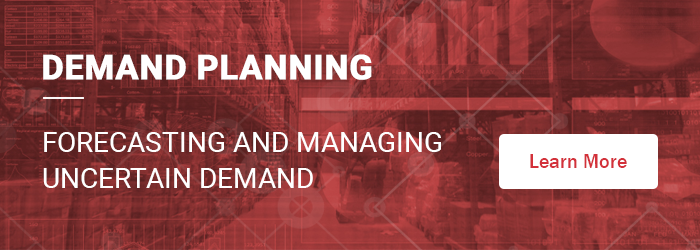Planificación de inventario desde la perspectiva de un físico
En un mundo perfecto, Just in Time (JIT) sería la solución adecuada para la gestión de inventario. Si puede predecir exactamente lo que necesita y dónde lo necesita y sus proveedores pueden obtener lo que necesita sin demora, entonces no necesita mantener mucho inventario localmente. Pero como dice el dicho del famoso pugilista Mike Tyson, “todos tienen un plan hasta que les dan un puñetazo en la boca”. Y el último golpe en la boca para la cadena de suministro global fue el Bloqueo del Canal de Suez de la semana pasada que retuvo $9.6B en el comercio con un costo estimado de $6.7M por minuto.[1]. Las interrupciones de estos y otros eventos similares deben modelarse y tenerse en cuenta en su planificación.
La suposición de que puedes exactamente Predice el futuro era evidente en las leyes de Isaac Newton. Desde la década de 1920 con la introducción de la física cuántica, la incertidumbre se volvió fundamental para nuestra comprensión de la naturaleza. La incertidumbre está integrada en la realidad fundamental. También debe integrarse en los procesos de planificación de la oferta y la demanda. Sin embargo, con demasiada frecuencia, los eventos del cisne negro, como el bloqueo del Canal de Suez, se consideran anomalías y, como resultado, se descartan al planificar. No es suficiente mirar hacia atrás en retrospectiva y proclamar que debería haberse esperado. Es necesario hacer algo para abordar la ocurrencia de otros eventos similares en el futuro y planificar los niveles de existencias en consecuencia.
Debemos ir más allá del pensamiento de "distribución de cola delgada" donde se descuentan los resultados extremos y planificar para "colas gruesas". Entonces, ¿cómo ejecutamos un plan JIT del mundo real cuando se trata de planificar el inventario? Para hacer esto, el primer paso es estimar el tiempo de entrega realista para obtener un artículo. Sin embargo, la estimación es difícil debido a la incertidumbre del tiempo de entrega. Utilizando los plazos de entrega reales de los proveedores en la base de datos de su empresa y los datos externos, puede desarrollar una distribución de posibles plazos de entrega y demandas futuras dentro de esos plazos de entrega. Pronóstico probabilístico le permitirá tener en cuenta las interrupciones y los eventos inusuales al no limitar sus estimaciones a lo que se ha observado únicamente en su propia demanda a corto plazo y datos de tiempo de entrega. Podrás generar posibles resultados con probabilidades asociadas para cada ocurrencia.
Una vez que tenga una estimación del tiempo de entrega y la distribución de la demanda, puede especificar el nivel de servicio necesitas tener para esa parte. Utilizando soluciones como Optimización de inventario inteligente (SIO), podrá almacenar con confianza en función del riesgo de agotamiento de existencias objetivo con un costo mínimo de mantenimiento de inventario. También puede considerar dejar que la solución prescriba objetivos de nivel de servicio óptimos mediante la evaluación de los costos de inventario adicional frente al costo de falta de existencias.
Finalmente, como ya he señalado, debemos aceptar que nunca podremos eliminar toda la incertidumbre. Como físico, siempre me ha intrigado el hecho de que, incluso en los niveles más básicos de la realidad tal como la entendemos hoy, todavía hay incertidumbre. Albert Einstein creía en la certeza (determinismo) de la ley física. Si fuera gerente de inventario, podría haber abogado por JIT porque creía que las leyes físicas deberían permitir una previsibilidad perfecta. Él dijo célebremente: “Dios no juega con los dados”. ¿O podría ser posible que el universo en el que existimos fuera un evento de "cisne negro" en un "verso múltiple" anterior que produjo un tipo particular de universo que nos permitió existir?
En la planificación de inventarios, como en la ciencia, no podemos escapar de la realidad de la incertidumbre y el impacto de eventos inusuales. Debemos planificar en consecuencia.
[1] https://www.bbc.com/news/business-56559073#:~:text=Looking%20at%20the%20bigger%20picture,0.2%20to%200.4%20percentage%20points.
Artículos Relacionados

Haga de la optimización de inventario impulsada por IA un aliado para su organización
En este blog, exploraremos cómo las organizaciones pueden lograr una eficiencia y precisión excepcionales con la optimización del inventario impulsada por la IA. Los métodos tradicionales de gestión de inventario a menudo resultan insuficientes debido a su naturaleza reactiva y su dependencia de procesos manuales. Mantener niveles óptimos de inventario es fundamental para satisfacer la demanda de los clientes y minimizar los costos. La introducción de la optimización del inventario impulsada por la IA puede reducir significativamente la carga de los procesos manuales, brindando alivio a los gerentes de la cadena de suministro de tareas tediosas.

Escenarios de demanda diaria
En este Videoblog explicaremos cómo la previsión de series temporales se ha convertido en una herramienta fundamental, especialmente a nivel diario, en la que Smart Software ha sido pionero desde sus inicios hace más de cuarenta años. La evolución de las prácticas comerciales de incrementos temporales anuales a incrementos temporales más refinados, como el análisis de datos mensual y ahora diario, ilustra un cambio significativo en las estrategias operativas.

Juego constructivo con gemelos digitales
Aquellos de ustedes que siguen temas candentes estarán familiarizados con el término "gemelo digital". Aquellos que han estado demasiado ocupados con el trabajo tal vez quieran seguir leyendo y ponerse al día. Si bien existen varias definiciones de gemelo digital, aquí hay una que funciona bien: un gemelo digital es una copia virtual dinámica de un activo físico, proceso, sistema o entorno que se parece y se comporta de manera idéntica a su contraparte del mundo real. Un gemelo digital ingiere datos y replica procesos para que pueda predecir posibles resultados de rendimiento y problemas que podría experimentar el producto del mundo real.












